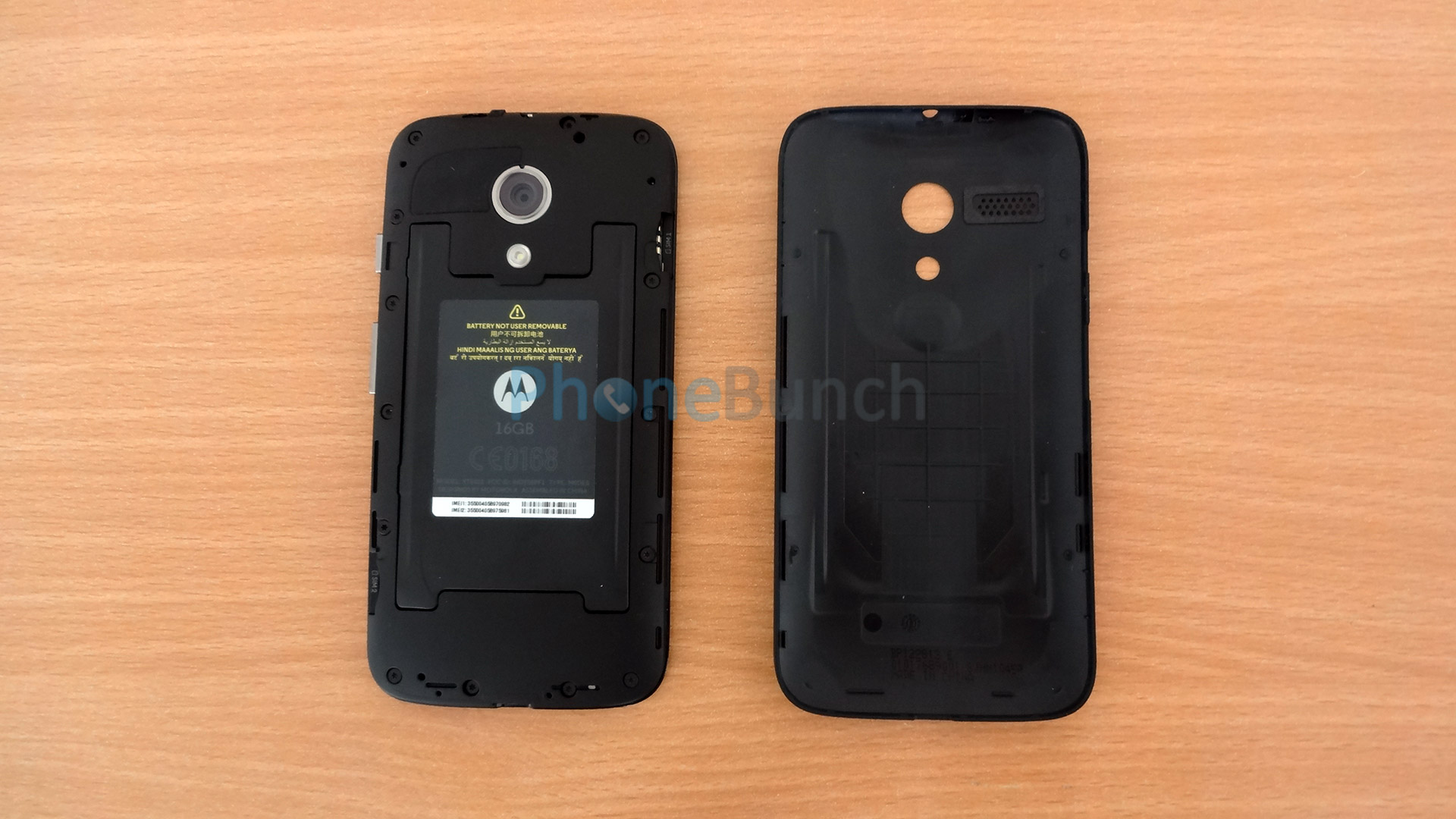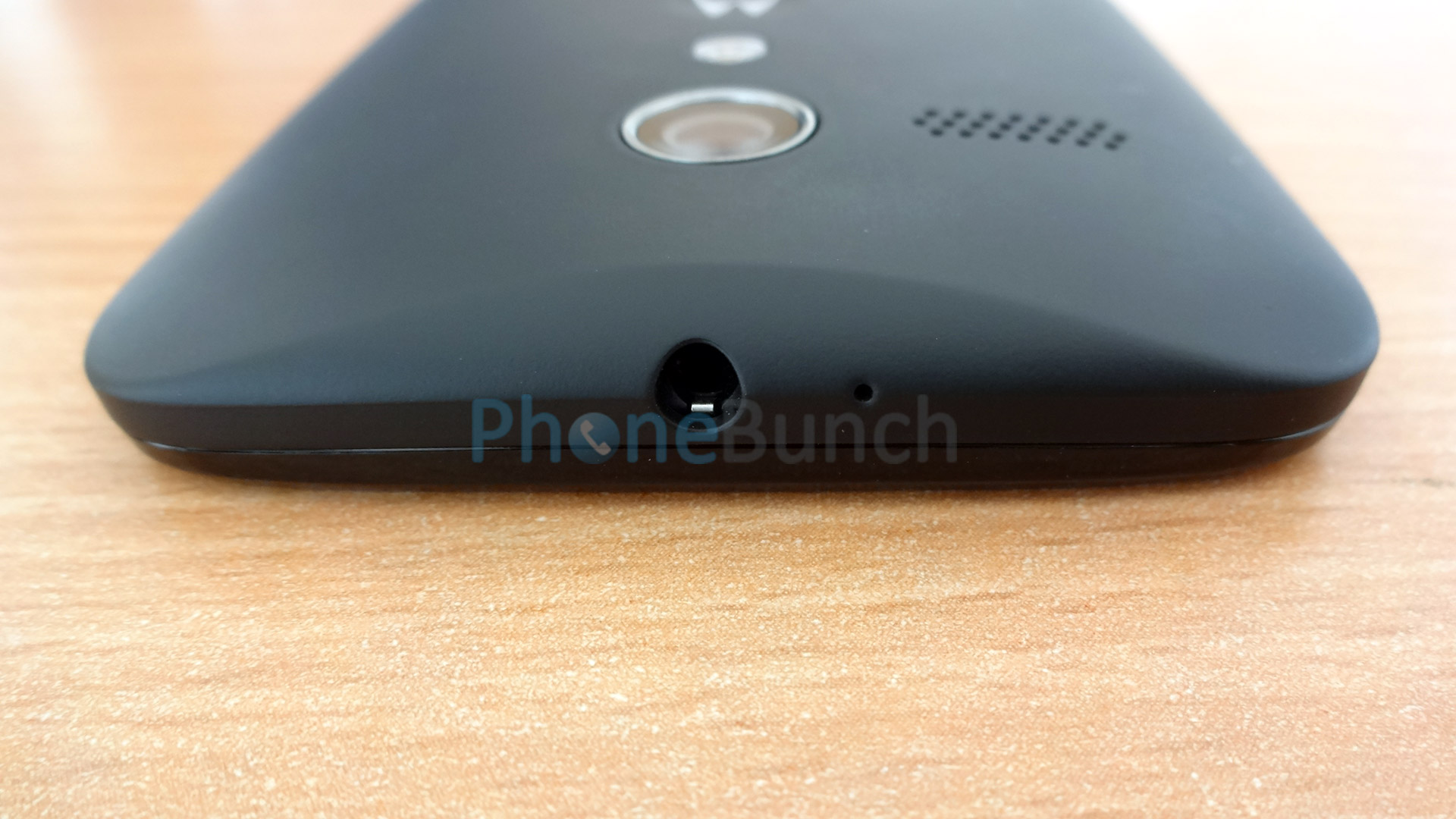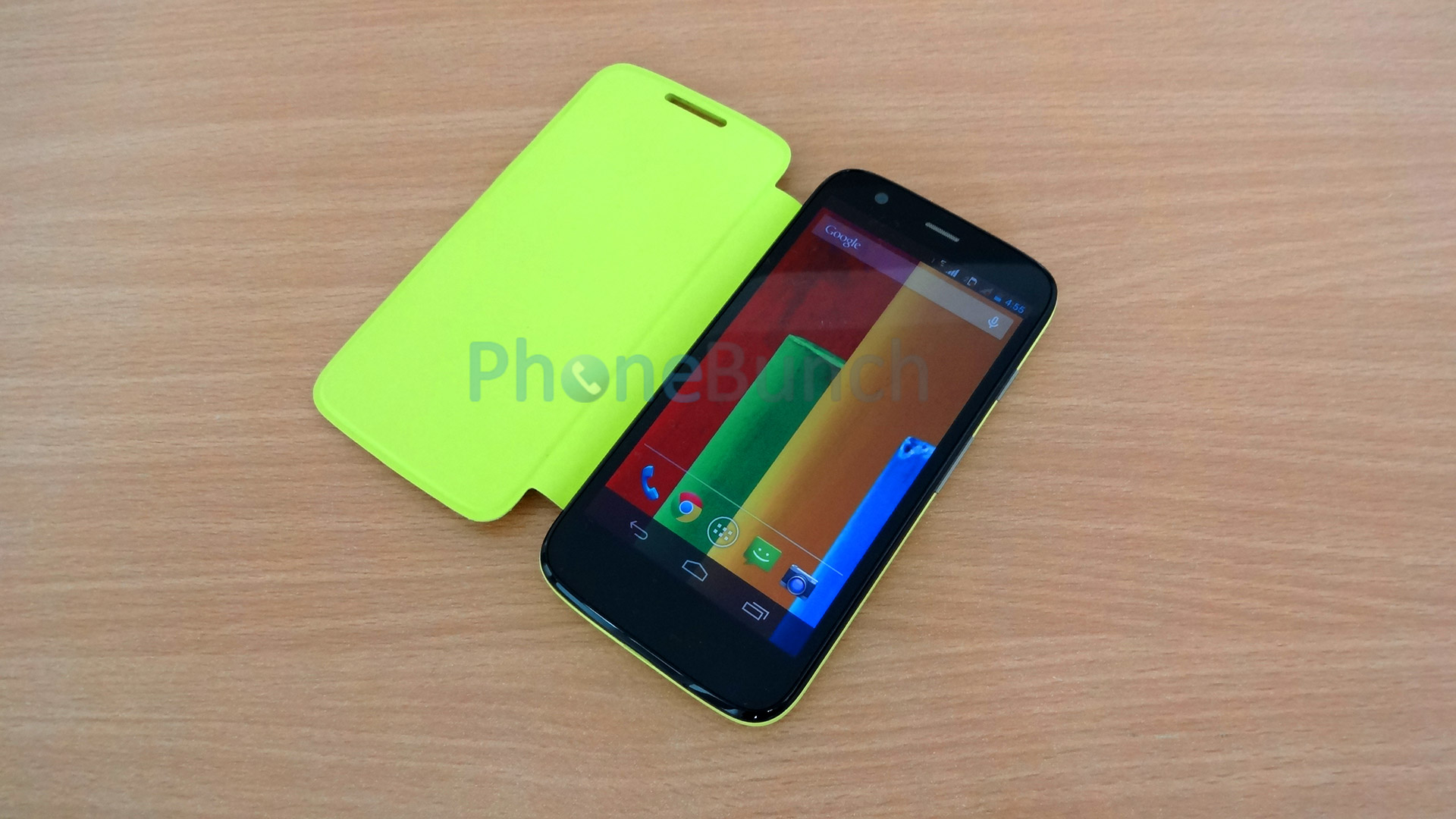Motorola has been one of the pioneers of the mobile world. The Moto X was a step in the right direction and gave Motorola a stage to make a comeback but with limited availability and geographic constraints it proved to be more of a hassle. Then came the Moto G which opened Motorola to the global stage. The Moto G features a 4.5-inch HD display, quad-core processor, 1 GB RAM running Android 4.4.2 KitKat making it one of the very few smartphones that are running the latest version of Android. With an acquisition by Lenovo pending, the Moto G has strengthened Motorola's presence in the world. Within a week of its launch the Moto G became the most sought after phone in India. So here's a look at the Moto G Dual-SIM in our full review.
Pros
- Bright and sharp HD display
- Superb Performance
- Excellent Build Quality
- Runs Stock Android 4.4.2 KitKat
- USB OTG Support
- Notification LED
- Personalize with Flip Shells and Backcovers
- Above average camera
- Loud speakerphone
- 1080p Video Playback
- Slo-Mo video Capture
Cons
- Limited Storage
- Non-removable Battery
Hardware Overview
The Moto G Dual-SIM comes with a 4.5-inch HD (1280x720 pixels) display, quad-core Snapdragon 400 processor with Adreno 305 GPU, 1 GB RAM running Android 4.4.2 KitKat. There's a 5 MP AF camera at the back alongwith a bright LED flash as well as a 1.3 MP front-facing camera.
The display on the Moto G is covered in Corning Gorilla Glass 3 making it scratch resistant. There's a protective water-resistant nano coating on the phone as well. Considering the pricing of the phone such high-end features make the Moto G truly desirable.

The Moto G Dual-SIM is a quad-band phone meaning it can virtually be used in any country on 3G networks. If you take a peak inside after opening the backcover you will find two micro SIM card slots alongwith a 2070 mAh non-removable battery. The GPS on the Moto G is quite accurate and geo-locates your accurate position within a second.

In terms of sensors you have:
- 3-axis Accelerometer
- 3-axis Magnetic Field Sensor
- Orientation Sensor
- Proximity Sensor
- Light Sensor
If we talk about hardware benchmarks the Moto G Dual-SIM Indian variant scored the following:
- Antutu 17103
- Quadrant 8575
- Vellamo HTML5 1958
- Vellamo Metal 563
- NenaMark2 57.7 FPS
These scores are before the Android 4.4.2 KitKat update but even after it the scores remained pretty much the same with a minor increase in most benchmarks.
We got the 16 GB variant for you, which comes with 12.9 GB of usable storage. The Moto G Dual SIM also supports USB OTG alongwith wireless input support both before and after the Android 4.4.2 KitKat update. You can see the first boot and our initial impressions of the Moto G Dual-SIM in our unboxing.
Build Quality
Straight off the bat I would like to say that the Moto G has excellent build quality. The curvature of the back sits firmly in your hand and the rubberized backcover makes it even easier to hold. Then there are the Shells and Flip Shell covers which help you personalize your Moto G.

At the top of the phone you have the 3.5 mm audio jack and right next to it you have a secondary noise-cancellation microphone. On the left there's just a vast expanse of plastic while you can find the power button and volume rocker on the right.

There's one thing though, the volume rocker as well as the power button are a bit wobbly. They offer good feedback but aren't that firmly set in their place.

At the bottom you have the micro USB data-syncing/charging port alongwith the primary microphone of the Moto G. Moving to the front you have a 4.5-inch Corning Gorilla Glass clad HD display, the main earpiece, a white notification LED, the front-facing camera as well as the proximity and light sensors.

Moving to the back you have the 5 MP AF camera with LED flash, loud speaker on the left and right below this you have the characteristic Motorola logo. The Moto G seems deceptively thin due to tits tapered egdes which give it a convex back making it a perfect fit for your palm. All buttons on the right make for easy one-handed use as well since you are able to reach both with minimum effort. There's also a protective water resistant nano-coating on the phone which protects it from minor water spills. The black backcover which comes default with the Moto G does attract fingerprints due to its rubberized finish but the other Moto Shells have just a matte paint and are less prone.
On opening the backcover you will find two micro SIM card slots, both towards the sides. One is on the right top and and the other at bottom left while the phone's back is facing you. But there's no micro SD card slot and the battery too is non-removable.
Customization

You can personalize your Moto G with a variety of Flip Shells and Backcovers which are available in different colors. We unboxed both the official Flip Shell and Shell cover for the Moto G. The Flip shell is actually a smart cover which activates the sleep sensor in the Moto G when the flip is closed or opened. The phone wakes up when the cover is opened and goes to sleep when closed. It works flawlessly. The build quality of these covers is excellent as well. Especially the Flip Shell which has a rubberized textured surface in both the front and back, plus it keeps itself locked in place with a magnetic lock.
Display
We have a 4.5-inch HD IPS display on the Moto G, which is a treat to look at. It has excellent viewing angles and the color reproduction is quite accurate. Blacks are deep and the contract levels hold good.

It looks sharp and bright, but sunlight visibility is average. The display performs far better than expected especially while playing games and there's no sign of flicker or ghosting.
Network & Call Quality
There were no network issues with the Moto G, call quality too is quite good. We didn't have any dropped calls, or any network issues both before and after the KitKat update. The phone dialer has received a major update with a new UI as well as smart search for contacts.

Noise cancellation too works and it reduces background sound when you are on a call. However, sometimes we did notice that sound got a bit muffled as well. The speakerphone is loud and clear during calls.
Camera

Moto G has a 5 MP Auto Focus camera with a very bright LED flash and is capable of recording 720p video at 30 FPS. It takes decent shots in bright light, but as the intensity of light decreases noise begins to creep into the frame. Low-light photography has quite a bit of noise but the flash sure helps a lot.
In ambient light, the camera takes great looking shots with adequate focus and sharpness. Images turn out to have natural looking colors and accurate exposure. There is a manual option in which you can change the metering based on where the scene is focused. In this mode, the focus point is movable on the screen and you can see the scene focus. Macro shots turn out to be excellent in this mode. Although it takes a second or two to focus for macro shots.
Moto G also supports Slow Motion video capture, which is just something to have fun with. The quality degrades a bit from the normal video capture mode, but the thing is this actually works.

Motorola uses its own camera app on the Moto G which isn't that feature rich but its bare-bones feature set is quite enough for some basic photography.
Normal video recording is smooth, and noise cancellation kicks in here as well. Voice recording is perceptively sharper with natural tone reflected in the recorded piece. The front-facing camera too has acceptable quality when it comes to making video calls.
Camera Samples






Speakerphone
The speakerphone on the Moto G is really loud. Generally we find phones especially in this segment lacking in this particular point. But not the Moto G, the sound is crisp and the speakerphone doesn't crackle even when its at the maximum volume.

In-fact most of the time you would have to lower the volume to keep in within desirable levels. Even though the speakerphone is on the flat of the back, the sound doesn't get muffled that much due to the phone's tapered design.
Music Playback and Bundled Headset
The bundled headset is quite good although it does look cheap. They have excellent bass reproduction and fit quite good in your ears even though they are not in-ear. Although we would have preferred some cushion as they are just plastic.

They have a silver 3.5 mm pin and a very clicky button to end and receive calls. With Android 4.4 KitKat the album-art of currently playing music is shown in full over the lockscreen with option to pause playback or jump to the previous or next tracks.

Music playback is excellent, everything sounds great on the loud speakerphone and there are no issues with high bit-rate content. The audio engine provides full output even on the 3.5mm audio jack making virtually every headset sound better.

FM Radio also works fine although the interface is quite limited and you cannot listen to radio through your speakerphone. There is no option to record FM as well. But we expect some of these changes to be incorporated with an update to Motorola's FM Radio app.
Video Playback
You can play 1080p videos natively on the Moto G, videos look crisp and play flawlessly. There are no issues with large video files, you can jump in between, fast forward without any ghosting and freezing.
There's no stuttering in even high profile video files. Many file formats are supported natively but you can always play more using MXPlayer or VLC which are available in the Play Store.
Storage
Storage is limited on the Moto G as you don't have a SD card slot. Therefore, you should get the 16 GB storage variant on which you will get 12.92 GB of storage. USB OTG is supported so you can store some media like movies or music if you are going on a journey.

The 8 GB storage variant has about 5.52 GB of storage and that's truly a limitation considering the price difference between the two.
Android 4.4.2 KitKat Update
This review was compiled after the Moto G Dual-SIM Indian variant was updated to Android 4.4.2 KitKat. Therefore,it would be moot to discuss pre-kitkat software/features of the Moto G. In terms of performance there was a slight increase but nothing major.

The Moto G is as it is quite fast and we never saw any lag throughout our usage. You can see our hands-on with the Moto G Dual SIM Android 4.4.2 KitKat update right here.

Android KitKat also gave the Moto G native USB OTG support, Immersive or FullScreen mode for apps, translucent notification and navigation bars and a lot of under the hood changes. We have already known that KitKat is optimized for entry-level devices but we can't really call the Moto G one. Nevertheless, it performs as well as it did after the update.
Software and Apps

Moto G runs a stock build of Android KitKat with just a few Motorola apps pre-installed including Moto Assist and Migrate. There's no customization here, making this is a pseudo Nexus device.

Moto Assist and Migrate both are quite useful in terms of providing automation as well as ability to transfer contacts, SMS and several other stuff form your old phone to the Moto G.

There's a lot to ponder over especially with the advent of Android KitKat which comes with inbuilt Cloud Printing support, Open GL ES 3.0 (although that was introduced in Android 4.3), smoother performance and security enhancements. With Android 4.4 KitKat Moto G Indian variant also got the option to disable the Notification LED from display settings alongwith an option to Cast Display (Wireless Display).

The launcher is stock with 5 home screens and so is the app drawer without any customization. You can add widgets to the lockscreen as well as disable them from Security settings. Here, you also have the option to use Face Unlock which actually works quite well. Default options like pin, password and slide work as advertised.

You also get full album-art over the lockscreen when music is playing on the device. The Gallery app has a new interface with Camera Roll, Timeline and Album views. Image filters have been improved upon from Android Jelly Bean and provide a more cohesive interface to work with. KitKat also introduced full-screen mode in apps which if used will make the notification bar as well as the status bar disappear allowing the app to use the full display.

The default web browser is Chrome and it works great. Even large websites with lots of images and text render fast. Scrolling is effortless, text renders quickly and everything looks crisp as it should on a HD display. The display on the Moto G is by far one of the best displays we have seen in this segment.
Gaming
Moto G Dual-SIM performed brilliantly in our Gaming reviews. We threw every game at it that we could and it came out with flying colors. There was no lag, no matter the game. The Moto G was never out of breath even when we played Asphalt 8, MC4, NOVA 3, NFS Most Wanted, Real Racing 3 and FIFA 14.
We tried basic games like Subway Surfers, Frontline Commando: D-day, Dead Trigger 2, Riptide GP2 among others and to no one's surprise it performed great. Adreno 305 in the Moto G seemed to work well beyond its capacity with relative ease.
Performance
We have been singing praises of the Moto G's performance all this while. Well here is some more. Throughout our review period we never saw the Moto G falter in terms of performance. There is no lag in the UI and apps launch instantaneously. If you want to count GPS geo-location into performance as well, that too works within milliseconds.
Benchmark scores of the Moto G Dual SIM Indian variant prove that it was already pretty optimized even before the KitKat update as scores both before and after the update are relatively quite close. There is no hiccup in opening apps, switching between apps or playing music while using several other apps. 1 GB RAM is utilized quite well on the Moto G, as it seems some is already reserved for the OS and the rest is available for user apps. Therefore, restricting closing or killing of user apps in favor of system apps.
Battery Life
The Dual-SIM Moto G can easily give you more than 1.5 days if you are a moderate user and have both SIM cards enabled. If you disable a SIM card battery life will increase. Then there's your routine, if you play games, listen to music for a long time you would not be able to get more than a day's worth.
But if you factor in the HD display, quad-core processor battery life is actually quite good on the Moto G. In average usage the Moto G Dual SIM can easily last more than one and a half days on one full charge.
Wrap-Up
Moto G is the best phone you can get if you are looking for a mid-range device. There isn't a better choice in the sub - $250 price bracket and the main thing is it can even beat some of the high-end devices when it comes to gaming and general performance.
The limited storage sure can be a bother for some. But these are far outweighed by the benefits the Moto G presents. You get a smartphone from a tier-1 company like Motorola with superior build quality, excellent display and superb performance with a lower-end price segment for a mid-range device. Then there's the fact that the Moto G Dual-SIM now runs Android 4.4.2 KitKat in India which is by far one of its best features. The camera is surely above average and so is the multimedia capabilities augmented by a loud speakerphone.
Moto G is truly a revelation, it performs better than its counterparts and looks better doing it. Then there are the various customization options with the Flip Shell and Shell backcovers which add a personal touch to your Moto G making it one of the most customizable smartphone available in the mid-range segment. The only competition available within this segment is the outdated Galaxy Core, the Xperia M, newly minted Galaxy Grand Neo and the Xperia L. But none of these hold a candle against the Moto G and there in is its value. We can wholeheartedly recommend the Moto G as one of the best smartphones you can get within the sub-Rs. 20000 price bracket.


.jpg)
 Comments
Comments










